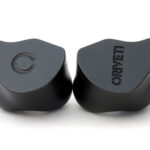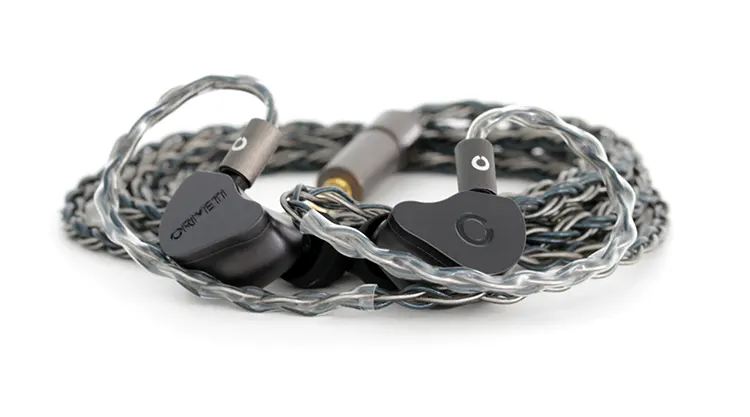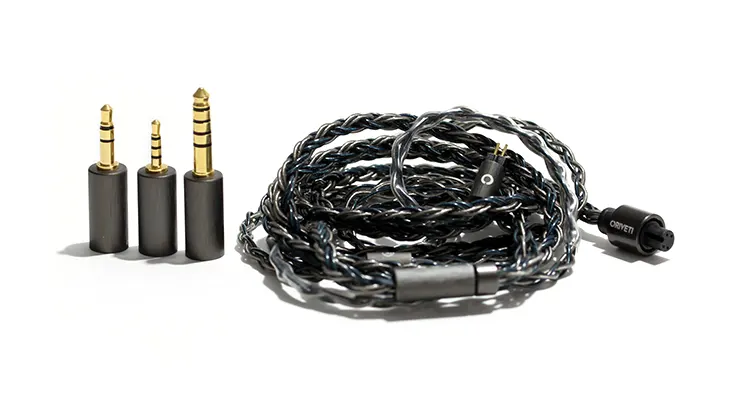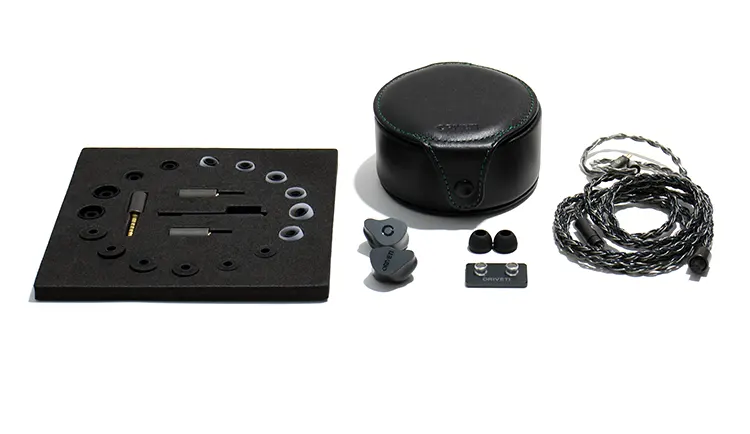We review the ORIVETI OD200, which is a new single BE-Coated 9.8mm dynamic driver universal IEM with a dual sound signature nozzle system. It is priced at $199.
Disclaimer: This sample was sent to us in exchange for our honest opinion. Headfonics is an independent website with no affiliate links or partnerships. We thank the team at ORIVETI for giving us their support.
Click here to read more about ORIVETI products we have previously featured on Headfonics.
Note, this review follows our current scoring guidelines which you can read up on in more detail here.
Recently, ORIVETI has reset and relaunched itself and introduced 3 new universal IEMs.
We recently covered the first of the bunch, the entry-level OD100. So today, we will cover the second in line which is the OD200 which is also a single dynamic driver universal IEM.
However, this model seems to have a higher level of refinement and some patented design implementations that up the ante as they say.
ORIVETI claims to have put many years of experience, research, and development into the OD200 and went to the design table with airflow control and driver optimization foremost in their minds.
Tech Highlights
The ORIVETI OD200 uses a solitaire proprietary beryllium-coated 9.8mm dynamic driver and is rated at 16Ω impedance with a sensitivity of 108db ±3db at 1mW and 1kHz. They also listed a distortion rating of 0.08%.
Those are not bad specifications but they seem average in general. However, specifications don’t tell the whole story as they say and I don’t want to give much away too early, but these IEMs do produce a clean, balanced, and natural-sounding timbre.
The single dynamic driver is placed inside a patented chamber system within the all-metal CNC machined universal fit ergonomic body that comes with two nozzle filters to further enable the user to customize their output and overall sound signature and to enhance synergy.
Design
ORIVETI implemented what they call a DAD, or a dedicated airflow distribution system within the shell of the OD200 that consists of two acoustic chambers, one front chamber, and one rear chamber.
What this design brings to the table is that it allows the driver to breathe freely while simultaneously controlling the driver’s motion. To me, it seems similar to what a cabinet effectively does for a raw speaker.
The main tuning component within this design seems to be a path tube that directs the airflow from the rear chamber and into the front chamber along with a couple of side nozzles that further vent the drivers and chambers. The side vent nozzles seem to act as speaker cabinet tuning ports.
Appearance? The shells are finished in British racing green and it’s a subtle color. The overall look lacks contrast and vibrance, and so does the packaging. But they are stealthy and some might prefer that over bling.
Comfort and Isolation
The method I use to test IEM comfort is to just wear them. When I received the ORIVETI OD200, I took them out of the box and wore them while I was at my desktop working.
I immediately opened up Foobar and played some tracks through my current setup. After a while, I had to check some Emails and do some other work-related things on the PC.
Four hours later, I seemed to have forgotten that I had them on. There was a time when no music was playing but kept them on anyhow. So I would say they’re very comfortable to wear and would categorize their comfort level as high.
As far as isolation, It seems to vary with tip selection. The best tips for isolation were the foam tips, followed by the black rubber tips and the silicon tips which were very similar in attenuation and in reducing outside noise.
Tips
The ORIVETI OD200 comes with black rubber tips preinstalled and most times they’re the best sonically but since the set comes with 3 types of tips plus two different output nozzle sizes, it becomes an interesting proposition to find the right selection due to so many available combinations.
The black tips are the most balanced sounding of the group that neither emphasizes any area of the overall recording nor shelves any frequencies. These are the more natural-sounding tips but some might prefer a more colorful presentation.
Some might prefer the white silicon tips because of comfort first and foremost. Second, the sound signature. These tips reveal high frequencies more vividly, the soundstage gains some width and placement definition.
The foam or comply tips widen the soundstage even further but some of the bass fundamental frequencies are recessed and bass impactfulness is reduced. These are my least favorite. The foam tips do isolate best as far as outside noise.
The OD200 tip selection changes are subtle to accredit the IEM but they’re there. The largest perceivable change was with the foam tips. I can say that the changes weren’t unpleasant.
The changes did not remove much of the enjoyment factor and just added an extra layer of versatility capability that lets you further fine-tune until you get the sound signature that suits you or that pairs best with your gear.
Stock Cable
The ORIVETI OD200 comes with a rather nice cable assembly that is handmade with OCC cable, twisted into an 8-wire braid main cable, followed by a pair of 4-wire braid sets on top.
The cable assembly itself is soft and pliable plus it doesn’t produce much microphonic noise, not much.
It’s also modular and terminated with a 4-pin miniature plug that allows the user to swap on the fly and install one of the 3 included plugs and go either balanced or single-ended. All you have to do is pull the plug outward to remove it. To install you just align the inner slot, and push it in to install.
The other ends are terminated with two 0.78mm connectors. The ear hook portion is not malleable but they’re very soft and won’t dig a channel into your ear, or at least in my case.
All the hardware is made from anodized metal, branded, and the cable assembly in general carries a quality and feature set rarely seen at this price level.
Packaging & Accessories
ORIVETI included a generous amount of useful goodies inside the box including an ample set of tips along with two sets of output nozzles. One set of nozzles comes mounted on a metal plate that’s ORIVETI branded and anodized to match the IEMs.
There are nine sets of tips included in total. There are three sets of black rubber tips, Three sets of foam tips, and three sets of white silicon tips. The IEMs come with one of the black rubber tip sets preinstalled.
The stock cable comes with three sets of connectors, a 4.4mm, a 3.5mm, and a 2.5mm connector. Most of these accessories come mounted inside a custom foam mold that also houses the tips and what seems to be an eyebrow brush.
There’s also a storage case included that’s ORIVETI brand embossed, covered in black faux leather, and assembled with green stitching. The flip top uses a snap-in-place fastener to keep the lid closed.
The product box itself copies the characteristics of a jewelry box. It keeps some of the contents inside a slide-out drawer at the bottom front portion of the box. The rest of the contents are on top below a magnetic flap. So the box has 2 compartments.
Sound Impressions
Methodology
An iFi Audio iDSD Diablo on FW 7.4 was used most of the time with the OD200. The gain setting was kept on low since the OD200 is a very sensitive set and doesn’t require much power to drive them.
A couple of dongles were also used to obtain a portability aspect. The FiiO KA13 and the MOONDROP MOONRIVER 2: TI were used. For fun factor testing, an iFi Audio hip-dac 3 was also used in conjunction with the XBass feature.
A Shanling M0 Pro to obtain a low-powered DAP and an ultra-portability perspective since this DAP also fits inside the storage case along with the OD200.
Replaceable Nozzles
Light or dark? The two nozzles suit two preferences. Their differences in design seem to be with the width of the nozzle since the front screens seem identical. The silver variant is wider and the black nozzle is narrower.
The silver nozzles present a balanced overall signature that fills in the treble response in comparison to the sonically darker black nozzles. The silver nozzles bring forth detail and increase high-frequency production which is reduced in the black variants.
The black variants present a darker perspective. They both allow you to dial in an extra 10 decibels or more on the bottom octave and the drivers will withstand the boost and provide visceral bass. The treble is reduced; however, the midrange is brought forward at an almost shouty level.
So which one is my favorite? The silver takes the win for me. It just presents the midrange in a silkier manner, retaining the deep bass response while simultaneously increasing the treble presence and definition.
So, they will be used for our listening test. This set was also broken in for at least 100 hours of playtime.
Bass
The bass response represents itself well and there’s plenty of it especially when you use the silver nozzles since it allows the deeper bass notes to come through and be more effective. You get a better representation of the sub-bass but it’s a centric and focused bass.
The bass is effective down to 23 Hz and below that, it goes into a slow decay. But you can effectively hear these drivers down to 20Hz which is right in line with ORIVETI’s specification listing.
The bass response is neutral, well-balanced with the rest of the spectrum, and medium-bodied in texture. The speed is also in the medium range but it’s fast enough and well behaved.
If you want an extra amount of oomph, the OD200 can take a serious amount of bass boost that can easily take these close to Basshead levels. So the bass is versatile and can work out for those who like a heavy bass response and those who want a clean response.
Midrange
There is a small dip and it seems to be around the lower mid frequencies but when I ran a tone sweep all the mid-band frequencies were produced evenly. Some might perceive this IEM as U-shaped sonically but the tone generator revealed it to be different from what one perceives.
I like the fact that male vocals sound natural, and wind instruments seem crisp. Female vocals have a sense of depth but at times seem overcooked.
I didn’t see any frequency graphs on this set but my ears hear a flat frequency response through the midrange until it reaches 1kHz and up to 2kHz where I hear a rise in output by a few decibels.
I did hear a small peak at 5kHz but the notorious 7k peak is recessed and well controlled on this set. So the mid bands never display much harshness due to the soft peaks and the absence of one at 7k. Timbre is natural and neutral.
Treble
The OD200 high frequencies display restraint, remain polite, and are produced with weight and character. They’re also well extended up to a certain point.
I’m quite impressed with the high frequencies as far as clarity. Perhaps some will perceive a lack of top-end presence above 15kHz but what’s there remains well controlled and enjoyable.
Every once in a while you get a peak that presents a shriek element but it only happens with bright recordings. But in general, they’re enjoyable and don’t present any anomalies by remaining cohesive.
Staging & Dynamics
The dynamic response is varied through the frequency range. For example, some of the mid-frequencies that are in the wind instrument range seem in balance while snares tend to have a medium amount of impact on tracks that have a heavy snare presence.
The ORIVETI OD200 can project sound far and wide. They can also project plenty of depth and some rear projection as well. On Dire Straits “Your latest trick”, the trumpet is clearly inside my head while the pedal steel guitar riff seems to be behind me.
There is precision within the staging but you have to focus on finding the location except for the high frequencies which remain well isolated in their perspective position. The layering aspect seems a bit smeared except for the high frequencies that image correctly and interestingly.
Click on page 2 below for our recommended pairings and selected comparisons.










